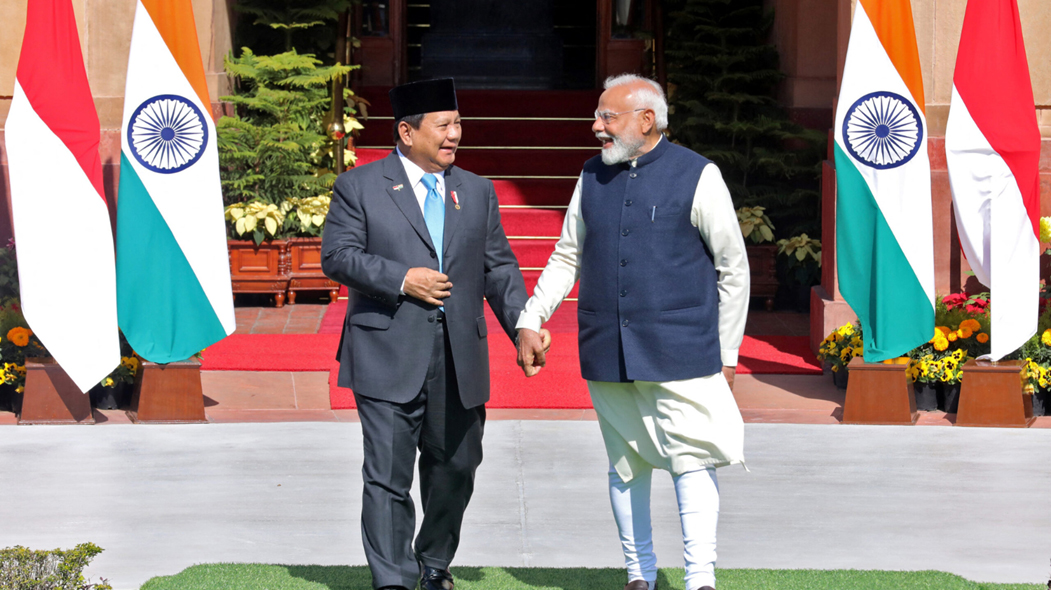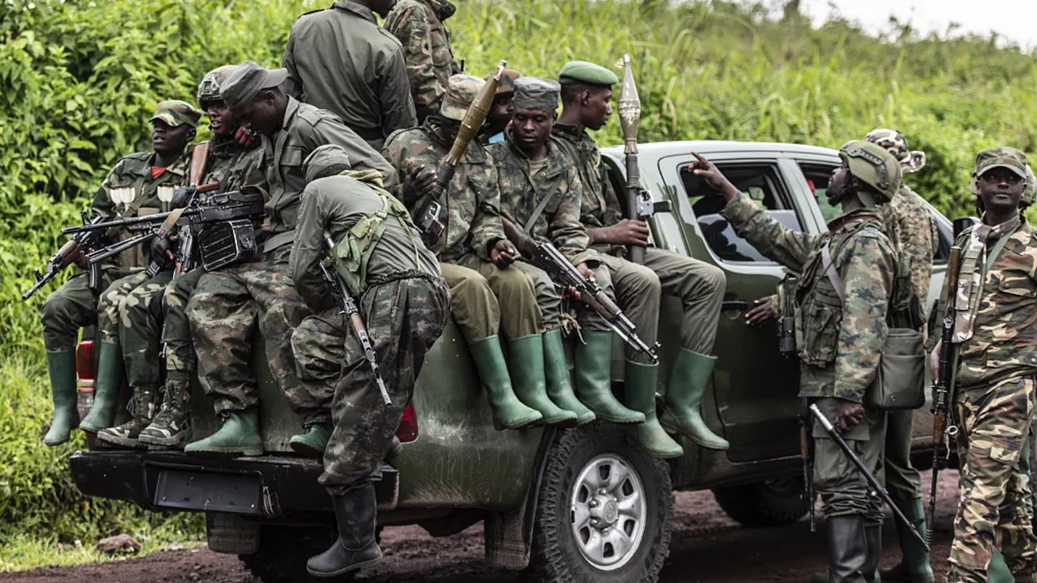The Recent Visit of Indonesia’s President to India
The Indonesian President Prabowo Subianto paid a state visit to India from 23rd-26th January 2025. He was then invited as the chief guest of the 76th Republic Day celebration in New Delhi. The visit coincided with the 75th Anniversary of India-Indonesia Diplomatic Relations. It enabled both the state leaders to review and hold a comprehensive discussion on their bilateral cooperation which compasses political, defence and security, maritime, economic, counter terrorism, health and pharmaceuticals, food and energy security, digital transition, science and technology, space cooperation, sustainable energy transition, blue economy as well as education and cultural cooperation.
Five Memorandum of Understanding (MOUs) were signed in health, traditional medicine, maritime safety and security cooperation, digital development and cultural cooperation. In addition, a joint statement was signed on the Agreement concerning Cooperation in the field of Defence (DCA). There were speculations that Indonesia is going to procure Brahmos Missile from India amid China’s growing territorial activities in the South China Sea. However, this did not materialize.
Since, the states of Southeast Asian region have witnessed the perils of bloc politics of the Cold War period, it has invoked cautiousness in the foreign policies of these states. As the world is living in the age of complex interdependence which is characterised by lack of hierarchy of issues which previously was fixated on military power and capabilities of the state actors; at present states tends to consider multiple dynamics before forging strong defence relations. This perspective can be used to view the likelihood of Indonesia to purchase Brahmos Missile from India in the coming times. The possibility of sealing this defence deal partially depends on the ties with China, level of dependence and the continuing power competition between the U.S. and China.
Indonesia-Malaysia-Thailand Growth Triangle (IMT-GT)
During this recent meeting between India and Indonesia, India had reaffirmed its commitment, cooperation and investment in the Indonesia-Malaysia-Thailand Growth Triangle.
The IMT-GT which provides a sub-regional framework, was formed in 1993. It is also known as the Northern Growth Triangle. The aim of this growth triangle was to push economic growth and development of the sub-region of these three states. In addition, the project aims to translate the regional strategy of Association of Southeast Asian Nations (ASEAN) into sub-regional actions. The geographical area of this GT included 10 provinces from Sumatra in Indonesia, 8 states of peninsular Malaysia and 14 provinces in Southern Thailand. The importance of the project stems from the fact that it aims to enhance economic cooperation between these three member states. The project is also built on historical, ethnic and cultural links which will supplement in reducing transportation, production and distribution costs by inducing development.
The focus of the IMT-GT is on a range of sectors such as- agriculture, halal and service cooperation, tourism, physical connectivity, trade and investment, digital transformation and connectivity, sustainable development and climate change etc. On the aspects of collaboration and investment- the Asian Development Bank (ADB) has been their development partner for the last two decades. The ADB supports both sub-regional programs in promoting cross-border infrastructure and economic integration. This initiative has also been included as a part of the ASEAN Summit. The main agenda of this sub-regional initiative is that it aims to stir market driven and private sector led growth which will eventually the economic resilience of this region.
Some of the major projects include- Green City Initiative, Sustainable Urban Development Framework Development Plan 2019-2036, Visit IMT-GT Year 2023-2025 etc. The flagship project IMT-GT vision for 2036 which was adopted by the 10th IMT-GT Summit held in Manila in April 2017, is based on the vision to develop this sub-region into an integrated, innovative, inclusive and sustainable by 2036. In addition, during the 27th IMT-GT Ministerial Meeting held on 6th August 2021 acknowledged that 14 out of 48 Physical Connectivity Projects (PCP) have been completed and the remaining are still under construction.
The completion of the Dumai-Melaka Ro-Ro Ferry service will be critical to the connectivity of the IMT-GT Economic Corridor 6. Moreover, this sub-regional initiative is not only limited to land connectivity (railway, toll gates and bridges) but also directed towards maritime and air connectivity (seaports, inland ports and airports). Some of the targeted areas of this initiative are located along the maritime route of the strategic Strait of Malacca, which will invariably help these states to enhance their port facilities. Overall, the IMT-GT seeks to address sub-regional developmental and connectivity gaps, making them viable spots for foreign investments from external state actors.
India’s Interests in the IMT-GT
The significance of the IMT-GT for India stems from the fact that Thailand, Malaysia and Indonesia are strategically located at the crossroads of the Indo-Pacific region. India has also shared historical people-to-people ties and maritime trade with these three states. Moreover, India has been sharing diplomatic relations with Thailand (1947), Malaysia (1957) and Indonesia (1947) respectively. In addition, India shares economic, defence and maritime cooperation with these three ASEAN states. As the Indo-Pacific region has become a theater of geopolitical and geoeconomic hotspot for power contestation India continues to be in one of the central positions in framing regional dynamics of power relations among states through its strategic engagement. Hence, continuity in India’s cooperation with the Southeast Asian states displays importance and a more-integrated vision for the Indo-Pacific region.
The IMT-GT offers scope for India to invest, integrate and enhance its interaction and cooperation. India’s engagement with this sub-regional initiative will help to boost its image of regional power. As mentioned above, given the wide range of sectors that IMT-GT caters to, it give a wide scope for India to cooperate with these three states at various levels. Moreover, if India continues to cater to the development of such sub-regional initiatives, it will ultimately lead to mutual growth and development of ASEAN and India.
Looking at the recent cooperation, the Energy Efficiency Services (EESL) which is a joint venture of social undertakings under the Ministry of Power, signed a Memorandum of Understanding (MOU) with the IMT-GT Joint Business Council (IMT-GT JBC) on February, 2023. Under this partnership, EESL has aimed to implement sustainable energy projects (such as rooftop solar. LED Street Light, energy efficiency programme), low-carbon emission and target Green City Action Plans 2022-2025. The continuing cooperation between India and IMT-GT was emphasised during the meeting between Indian High Commissioner Mr. B. N. Reddy became the Director of the Center of IMT-GT on 15th December 2023.
On the other hand, as connectivity and infrastructure development is one of the nitty-gritties of the IMT-GT, India’s collaboration will help to fill the infrastructural gaps. According to the ADB’s report on Asian Infrastructure, the region’s annual infrastructure needs will increase to $1.7 trillion or $2.6 trillion between the period from 2016-2030. Being a development partner of IMT-GT, India has proposed connectivity projects encompassing- physical, infrastructural and digital connectivity. The India-Myanmar-Thailand Trilateral Highway (IMTTH) is an ongoing connectivity project and India can also look into collaborating with the Kuala-Lumpur Transport Strategic Plan (2016-25).
Although the IMTTH has been suffering setbacks since the military coup in Myanmar (2021) and followed by the outbreak of the ethnic violence in Manipur (2023). There is a lot of scope for India to collaborate and cooperate in such sub-regional initiatives. However, China’s Belt and Road Initiative (BRI) and Japan’s Partnership for Quality Infrastructure (PQI) are the two major infrastructure development initiatives in this region. There are vital differences in the approach, terms and conditions of soft and hard infrastructure loans of the above-mentioned initiatives. However, these two initiatives have already set strong footholds in the region. For instance, in January 2025, Japanese Prime Minister Ishiba Shigeru announced a set of projects in Indonesia worth $815 million. Simultaneously, the high-speed railway which connects Thailand and China through Laos which is a $6 billion project (70% venture is owned by China) is set to be completed by 2030.
Given the presence of such strong competitors in the region, India needs to vamp up its infrastructure investment initiatives; as mere reassurances on bilateral policy documents does not yield concrete results. Moreover, India has critical maritime security and energy interests. It needs to closely cooperate with these states at bilateral, sub-regional and regional levels. Henceforth, as this region is having a market for infrastructure investment, it brings a lot of scope for India to invest in connectivity and infrastructure projects.




